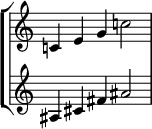

| Component intervals from root | |
|---|---|
| diminished seventh | |
| minor sixth | |
| diminished fifth | |
| minor third | |
| diminished third | |
| root | |
| Forte no. | |
| 6-30 |
The Petrushka chord is a recurring polytonal device used in Igor Stravinsky's ballet Petrushka and in later music. These two major triads, C major and F♯ major – a tritone apart – clash, "horribly with each other", when sounded together and create a dissonant chord.[1]
The Petrushka chord in the piano during the second tableau of Petrushka[2] is shown below.

The Petrushka chord is defined as two simultaneous major triads separated by a tritone. In Petrushka, Stravinsky used C major on top of F♯ major (the latter presented here in first inversion):

The device uses tones that, together, make up a synthetic hexatonic scale (0 1 4 6 7 t). When enharmonically spelled C–D♭–E–G♭–G(♮)–B♭, it is called the tritone scale.[3][unreliable source?] Alternatively, when spelled C–D♭–E–F♯–G–B♭, it can be read as the auxiliary diminished scale.[4]
The chords may be considered to contradict each other because of the tritone relationship: "Any tendency for a tonality to emerge may be avoided by introducing a note three whole tones distant from the key note of that tonality."[5]
At the end of the third tableau, the Petrushka chord appears with Petrushka but at A and E♭, which, with C and F♯, create a diminished seventh chord (0, 3, 6, 9) and exhaust the octatonic scale (9 1 4, 3 7 t, 0 4 7, and 6 t 1 = 0 1 3 4 6 7 9 t), "and suggests that it did... possess for Stravinsky an a priori conceptual status".[6]

Although attributed to Stravinsky, the chord (or, more precisely, two simultaneous major chords set a tritone apart, specifically F and B major) was present much earlier in Franz Liszt's Malédiction Concerto.[7] (Although the exact date of the composition remains unknown, it is estimated by Humphrey Searle to be from about 1840; the composition is believed to have originated from one of Liszt's early works, performed in 1827.[8])
Maurice Ravel uses this chord in his piano work Jeux d'eau to create flourishing, water-like sounds that characterize the piece. In his article "Ravel's 'Russian' Period: Octatonicism in His Early Works, 1893-1908", Steven Baur notes that Jeux d'eau was composed in 1901, ten years before Stravinsky composed Petrushka (1911), suggesting that Stravinsky may have learned the trick from Ravel. Stravinsky heard Jeux d'eau and several other works by Ravel no later than 1907 at the "Evenings for Contemporary Music" program.[9]
Stravinsky used the chord repeatedly throughout the ballet Petrushka to represent the puppet and devised the chord to represent the puppet's mocking of the crowd at the Shrovetide Fair.[10] Eric Walter White suggests and dismisses the possibility that the Petrushka chord is derived from Messiaen's "second Modes of limited transposition" (the octatonic scale) in favor of a "black key/white key bitonality" which results from, "Stravinsky's well known habit of composing at the piano."[11]
The 1979 song "Kogaion" by Romanian progressive rock band Sfinx makes use of the chord.
The Petrushka chord is dominantly used in the track Above the Clouds, from the 2003 simulation game Sim City 4.
|
| |||||||||
|---|---|---|---|---|---|---|---|---|---|
| Operas and musical dramas |
| ||||||||
| Ballets |
| ||||||||
| Symphonies |
| ||||||||
| Orchestral music |
| ||||||||
| Concertos |
| ||||||||
| Solo vocal |
| ||||||||
| Choral |
| ||||||||
| Piano and pianola |
| ||||||||
| Chamber music |
| ||||||||
| Other |
| ||||||||
| Arrangements |
| ||||||||
| Family |
| ||||||||
| Named for Stravinsky |
| ||||||||
| Related |
| ||||||||
| |||||||||
|
| ||||||||||||||
|---|---|---|---|---|---|---|---|---|---|---|---|---|---|---|
| By form |
| |||||||||||||
| Byfunction |
| |||||||||||||
| Techniques |
| |||||||||||||
| Other |
| |||||||||||||